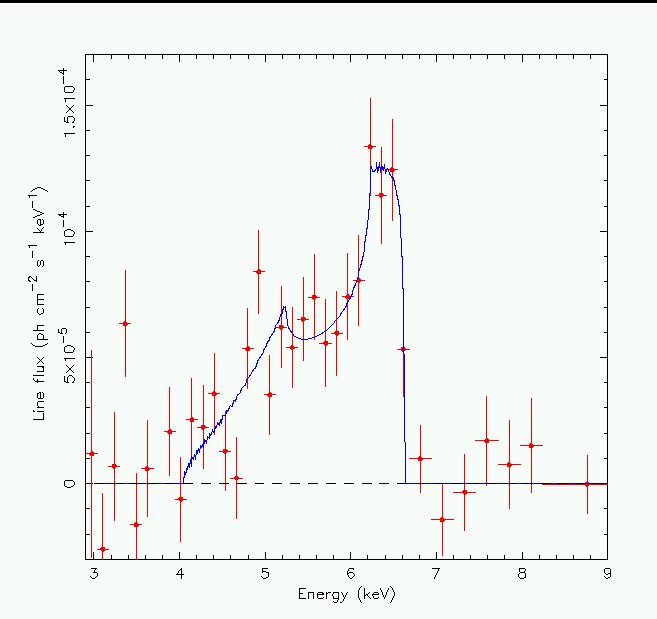
 Credit: Tanaka et al. (Nature 375, 659) / P. Nandra NASA/GSFC
Credit: Tanaka et al. (Nature 375, 659) / P. Nandra NASA/GSFC
A Daily Intake of Iron
So-called "active" galaxies (galaxies which are extremely bright at some
wavelengths, or which eject jets of matter ) produce spectacular
astrophysical fireworks. It is thought that these fireworks are caused
somehow by a "central engine", an active nucleus which probably harbors a
supermassive black hole weighing more than 1 million suns. Presumably,
matter from the galaxy (gas clouds, stars, perhaps planets and
civilizations) near the black hole spiral nearer and near the "event
horizon", moving faster and faster until swallowed by the black hole.
It's impossible to see into the event horizon, but of course that doesn't
stop astronomers from trying. The above image shows an ASCA X-ray measure of an iron emission
line from the active galaxy known as MCG-6-30-15. This iron emission line
(represented by the red dots) is produced only in extremely hot and/or
energetic regions of space. Through the study of this line astronomers can
determine the properties of the material producing the line. Astronomers
find that the iron emission from MCG-6-30-15 is very peculiar. The
width of the line suggests that the material is moving very fast, probably
at a velocity approaching 1/3 the speed of light. In addition, the emission
line has a peculiar double-peaked structure. This double-peaked structure
can be produced by intense gravitational field. Taking all the evidence
together, astronomers believe that this emission line is produced by
material in a death spiral very close to the supermassive black hole of
MCG-6-30-15, just before the material is swallowed into the depths beyond
the event horizon. The blue line shows the expected shape of the emission
line if the emitting material is at a distance of 3 to 10 times the event
horizon.
Last Week *
HEA Dictionary * Archive
* Search HEAPOW
* Education
Each week the HEASARC
brings you new, exciting and beautiful images from X-ray and Gamma ray
astronomy. Check back each week and be sure to check out the HEAPOW archive!
Page Author: Dr. Michael F.
Corcoran
Last modified August 30, 2000


